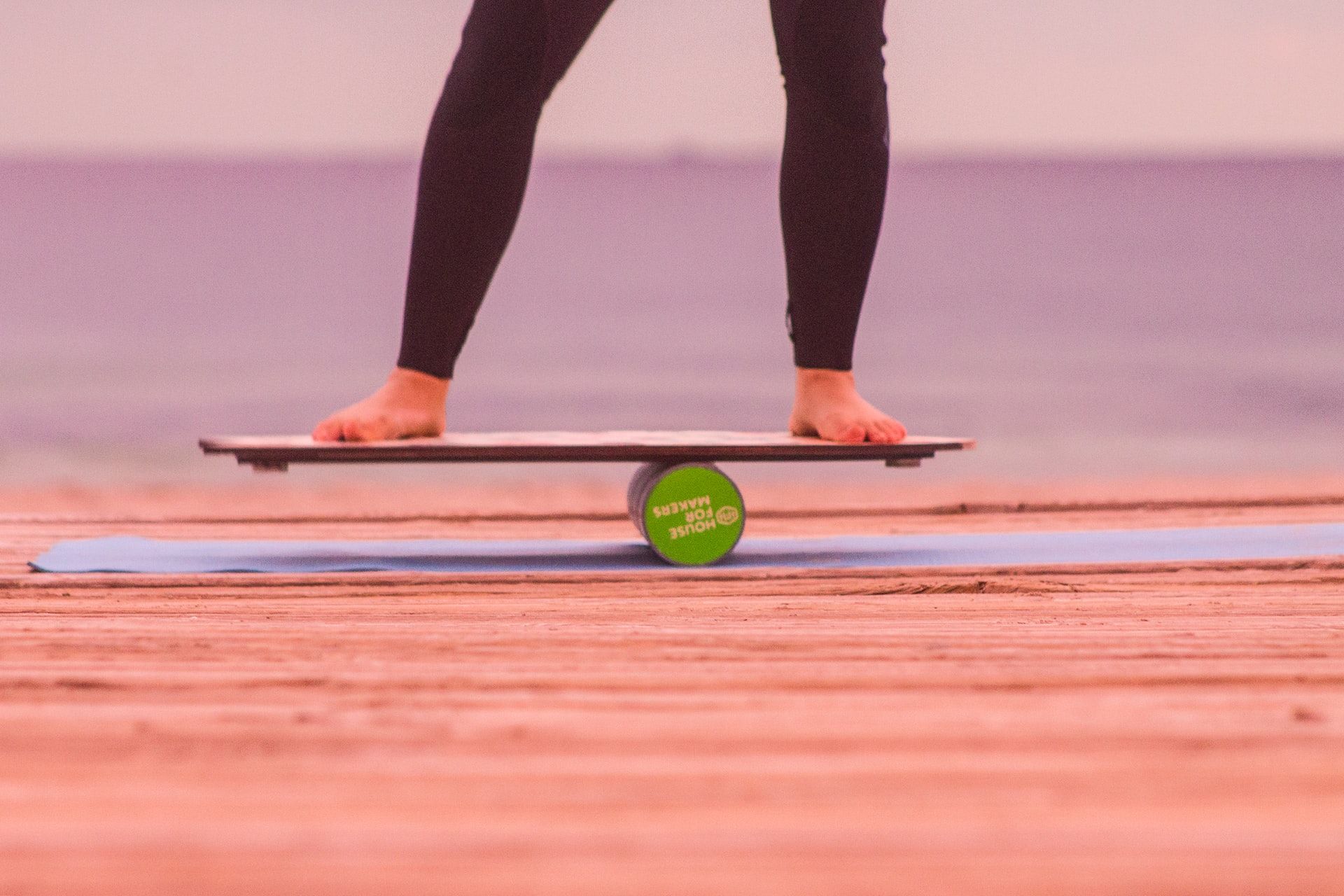Sitting all the time is an unhealthy habit, so getting a standing desk is a good idea. Even that, however, can put a strain on your body, especially if you use the desk for long periods.
Besides sitting down now and then, learn the following exercises, as they’re perfect for staving off aches and pains and just working out while on the job. There are also tools and apps that can boost your workplace fitness.
1. Walk or Jog on the Spot
Whether you do little steps or speed up and raise your knees more, moving at your desk can be as effective as going for an actual stroll or jog.
This exercise keeps your legs and whole body active if you add arm movement, too. It gets your heart pumping, increasing circulation and mental stimulation.
You may get more productive as a result. Exercising while working really can improve your creativity and help you avoid burning out at work.
2. Heel Raises
One of the simplest standing desk exercises you can do involves raising yourself onto your toes, making sure your heels are up and your body straight. Go up and down for a few sets.
If you want guidance and a timer, get to know apps for staying fit at your desk like Office Workout Exercises for Android or Office Active for iOS. They can remind you to work out and put your exercises into one-minute slots, for example.
As for what the heel raising exercise does, it stretches your whole leg but also works your calves and core, especially if you do it without holding onto the desk.
3. Glute Exercises
Another very simple but healthy exercise is the gluteal squeeze. Stand straight with your legs at hip-width and bent slightly at the knees. Then, just squeeze your glutes for a few seconds—ensuring your pelvis shifts forward a little—and release. A few sets will do the trick.
There are many other exercises for your glutes that can ease tension and keep you fit at your stand-up desk. They're even better with a resistance band.
For example, glute kickbacks have you extend one leg backward with your core engaged and back straight. The resistance added by a band around your ankles makes your legs work harder and improves the overall workout.
4. Balancing Exercises
Lift one leg off the ground and keep your balance with or without the desk’s support. It activates your standing leg and core, while your raised limb can do different movements.
You can work your glutes by bringing your knee up and then stretch your hip muscles by turning that leg outwards. Bring the leg down and repeat the exercise.
Another option is to raise your leg to the side, bend your knee so that your heel is near your backside, and lower the leg. Repeat this to engage and stretch your glutes.
A standing desk is also perfect for hamstring curls. All you do is keep your legs parallel and bend one knee to lift the calve, aiming for a 90-degree angle. Again, repetition is key.
A fourth great exercise is a yoga tree pose, where you place your raised foot against your other leg to form a triangle. Hold the position to improve your balance and give you a nice stretch. In fact, there are lots of yoga poses that can ease your work strains.
5. Balance Board Exercises
To make your standing desk workouts more interesting, get a balance board. There are different shapes and sizes, but a circular one is quite practical if you have limited space.
When on the board, you engage most of your body by just trying to keep your balance, a skill you can improve with regular practice. But exercises are easier if you use the desk for support.
You can stretch your legs by pushing one side of the board to the floor—almost like a side lunge. If you roll the board round and round with one edge always touching down, you can loosen your hips and knees.
For an extra challenge, try doing the leg exercises from the previous section on the balance board. If you enjoy such workouts and your workplace allows it, upgrade to something like a Bosu ball and combine it with digital tools like the Bosu Balance Trainer app.
6. Standing Desk Squats
To engage your legs even more and give your hips a workout, do some squats. The height of a standing desk is handy—hold onto the edges and ease yourself into position.
You’ll find classic and quick exercises like this on fitness apps like 7 Minutes Workout, J&J Official 7 Minute Workout, and Seven.
7. Side Lunges
Another familiar exercise that’s good for standing desk workers is the side lunge to stretch and wake up your legs.
Once again, you can use the desk to position yourself—squatting over one leg, while stretching the other out to the side. Switch positions a few times for a uniform stretch.
8. Standing Desk Push-Ups
Unfortunately, even the best ergonomic standing desks might affect your shoulders and back as well as your legs if you’re not careful with your posture or don’t take regular breaks.
So, exercises that strengthen or loosen your upper body are important to know, if only to ensure you can keep working at this type of desk pain-free.
For starters, if your desk is solid enough, you can do push-ups against it. Just place your feet further back, rest your hands against the desk’s edges shoulder-length apart, and lean forward with your body straight. Use a wall if the desk won’t do.
9. Arm Stretches
Just having your hands sit in the same position for several hours can strain your whole arms, so make sure you stand ergonomically and stretch regularly. Here are some exercises to try:
- Drop your arms at your sides and roll your shoulders back and forth.
- Intertwine your fingers behind your back and extend your arms, pushing upwards slightly to feel a pull in your shoulders—don’t go beyond what’s comfortable.
- Bend one arm over and the other under their respective shoulders and try to get your hands touching—even if you can’t, you’re stretching. Switch your arms’ positioning.
Services like STRETCHIT offer lots of workouts of different difficulty levels that can ease muscle tension and improve your flexibility. Discover top mobile apps for stretching exercises and pick the best for your lifestyle.
10. Twisting Back Stretch
Place one hand on the opposite corner of your standing desk and twist your torso towards the back wall.
Looking in that direction and striking a power pose with the opposite arm stretches your neck as well as your back. Repeat the exercise on your other side.
11. Neck Stretches
Depending on the work you do at your desk, your head may be angled down or up, which isn’t a healthy position to hold for long.
If possible, adjust the desk’s height, while also using exercises to stretch your neck muscles such as:
- Slowly lower your head forward, back, and side to side.
- Roll your head all the way around in both directions.
- Turn your head to look right and left, holding each position for a few seconds.
12. Light Dancing
Perhaps the best part of using a standing desk is that you’re ready to dance if the mood hits you. Feel free to create a work playlist on Apple Music and include tracks that get you bobbing and swaying without breaking your concentration too much.
You can increase your heart rate further with more intense dancing during a break. Either way, your work’s fun and fitness factors go up.
Level Up Your Standing Desk Exercises
You can do all of the exercises above with and without equipment. They’re easy ways to stay fit at a standing desk and keep your joints and muscles from hurting.
However, don’t forget how many opportunities there are to upgrade your workouts with apps, websites, and gadgets. Assess your workspace and what tools would suit it before exploring your available fitness options.


